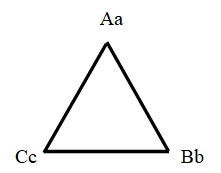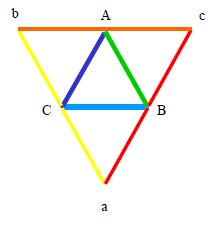References
Sometimes beauty may reveal order where the intellect fails
Kevin Kingsland (1996) on the Genesis of Spectrum Theory
~ ~ ~
India’s Contribution to Mathematics is Zero
Sanskrit and the Vedas
Newton's prism
Carl Jung's functions and Buddha's skandhas
The CAB triangle
Gorakhnath's system of realms
The CAB model completed
The CAB triangle extended
CAB = Gunas
Chakras and colours
Zhuan Falun (Turning The Law Wheel)
Spectrum Theory
~ ~ ~
‘India’s Contribution to Mathematics is Zero’
Many people are aware that the origins of "Western" decimal arithmetic can be traced back to "Arabic" numerals, which in turn came from Indian sources. Less well-recognised is that the arithmetic and mathematics can be found in classical Sanskrit. A good example of this is Baudhāyana Sulba Sūtra dating back to around 800 BC, well before the same theorem was "invented" by Pythagoras in Greece.
~ ~ ~
Why does this matter?
A similar situation exists for models of personality. These can also be found in classical Indian literature, which closely resemble the models that came later from Carl Jung.
Sanskrit and the Vedas
One of the names of the sun in Sanskrit is "saptasvaan" which means seven (sapta) horses (asva).
Asva also means "rays". The reference is to the seven coloured rays the sun emits (VIBGYOR).
Taittareeya Aaranyaka of the Vedas says that a single ray is known by seven names
"Eko Asvah Vahati Saptanaama",
that is to say, the single colour, white splits on refraction into seven colours.
Ref: p. 156, Sri Chandrasekharendra Saraswati, The Vedas, Bharatiya Vidya Bhavan, 1991.
It's worth noting that the Taittareeya Aaranyaka may have been written several centuries before Isaac Newton's famous prism experiment.
~ ~ ~

~ ~ ~
How does this all connect together?
The more well-known history of personality models (for English speaking people) starts with Carl Jung, who delineated the world we experience thus:
- two ways of looking (sensing or intuiting)
- two ways of considering things (thinking or feeling)
- two ways of apprehending phonomena (perceiving or judging)
What is not widely known or appreciated is how amazingly close Jung's functions are to those of Buddha's skandhas.
佛
| Buddha's skandhas | Jung's functions |
|---|---|
| forms (rupa) | sensing |
| feelings (vedana) | feeling |
| perceptions (samjna) | perceiving |
| dispositions (samskara) | judging |
| consciousness (vijnana) | thinking |
| intuition |
These differentiated six different types of person, in terms of their Cognitive (C), Affective (A) and Behavioural (B) attributes. In the following table, an upper-case letter symbolises an enabled or active attribute, a lower-case letter symbolises an unenabled or passive attribute.
| Function | Attribute |
|---|---|
| Intuition | CAb |
| Sensing | caB |
| Thinking | CaB |
| Feeling | cAb |
| Perceiving | Cab |
| Judging | cAB |
This defines a simple symbolic logic, as an aide-memoire for the parts of our personalities which are turned on, energised and functioning (or not). But this is functionally incomplete.

You might (in passing) notice that the CAB triangle pleasingly resembles Newton's prism. Mathematically, there are more permutations of "cab" and "CAB". This systems approach to psychology and types of personality was explicitly recognised in the Siddha Siddhanta Paddhati (by Gorakhnath). Gorakhnath describes a system of realms or worlds (Loka):
| Loka | Gorakhnath's realms |
|---|---|
| Jada-Jagat | Material bodies and physical forces |
| Prana-Jagat | Life and biological forces |
| Mano-Jagat | Perceptual experiences |
| Vijnana-Jagat | Discriminating intelligence - Buddhi |
| Dharma | Moral consciousness and order |
| Rasa | Aesthetic order |
| Ananda | Creative potential |
Here we have the spectrum cast of characters, as completed by Kevin Kingsland, and put in the public domain in a series of lectures to Business Psychology students from 2002 onwards. This is the version publically shared by Kevin Kingsland, and described by Ronnie Lessem, in "From Management Education to Civic Reconstruction: The Emerging Ecology of Organisation" (Ref Table 7)
| Calibration | Colour | Type | Quality |
|---|---|---|---|
| CAB | Violet | Creative / Innovator | Innovative |
| CAb | Indigo | Intuitive / Enabler | Developmental |
| CaB | Blue | Cognitive / Executive | Analytical |
| cAB | Green | Feeling / Ego / Entrepreneur | Enterprising |
| Cab | Yellow | Intellectual / Change agent | Adaptive |
| cAb | Orange | Social / Animateur | Sociable |
| caB | Red | Physical / Adventurer | Active |
| cab | Grey | Adopter | Imitative |
"All psychological phenomena have Cognitive, Affective and Behavioural aspects"
Ref: personal correspondence with Kevin Kingsland (1996) on the Genesis of Spectrum Theory.
The spectrum colours mentioned above works very well as an additional aide-memoire. They also reflect the energy levels of our personalities. Violet is at the higher energy end of the light spectrum compared to red. The more complete a personality is, the more levels of personality are energised and functioning.
Here is another representation of the CAB triangle; this one emphasises the distinctions between active and passive qualities (Cc, Aa or Bb), and how our psychological space is constructed.

~ ~ ~
CAB = Gunas
The name Guna comes from Sanskrit and Samkya philosophy, and (depending on the translation) for the individual person means “quality” , “attribute” or “virtue”.
There are three gunas:
- Sattva (Cognitive or awareness)
- Rajas (Affective or emotional)
- Tamas (Behavioural or physical)
The same gunas may also means “strand” or “fiber”; that is, like the strands of a rope, the gunas are woven together to form the universe we perceive outside of our selves. The external "reality" mirrors the internal reality we each construct, depending on our personality. Exactly as with the CAB model, everyone can have all three gunas, it's just the mix, balance or proportions of the three that varies from person to person.
In the Vedic traditions : "All phenomena are composed of gunas (Sanskrit = quality/string), three substantial qualities that emerge from an unmanifest, transcendental state"
Ref: personal correspondence with Kevin Kingsland (1996) on the Genesis of Spectrum Theory.
~ ~ ~
Chakras and colours
It is no coincidence that these colours match exactly (and purposefully) with the seven colours associated with Chakras in Indian yoga, meditation and psychology.

~ ~ ~
From a recent translation of Zhuan Falun (Turning The Law Wheel)
One standard alone determines if someone is good or bad: Whether he is able to be true, good, and endure. .. Buddhists emphasize the Good of True, Good, Endure, in their cultivation. Cultivation of Good can develop a heart of great compassion, and once this heart of great compassion comes out you can see that all sentient beings are suffering, so you’ll be filled with one wish: to save all sentient beings. But they also have True, and they also have Endure, it’s just that the emphasis is on cultivating Good.
There is a resonant affinity between these three qualities (True, Good, Endure) and the three Gunas.
- Sattva (Cognitive or awareness) = True
- Rajas (Affective or emotional) = Good
- Tamas (Behavioural or physical) = Endure
~ ~ ~
Spectrum Theory
Spectrum Theory grew as a coherent and powerful superset of all other models of human psychology. Along with Vision-to-Action as a model for personal and business development, it has been taught to thousands of people around the world.
Ref : Centre for Human Communication
~ ~ ~
Caring for life
https://nicholforest.wordpress.com/2012/07/13/caring-for-life/
~ ~ ~